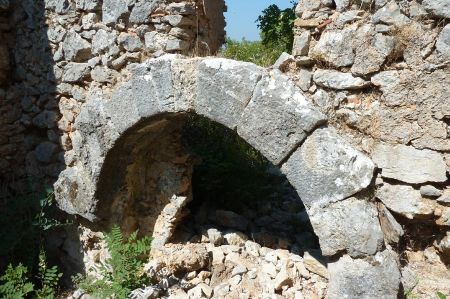Hamaxia - lost city near Alanya
- Written by Portal Editor
A few years have passed since we were last on the 400-meter-high mountain right next to the new road tunnels near Alanya to visit the Helenistic ruined city of Hamaxia, which is just over half an hour's walk and within sight of Cleopatra's beach.
At that time, it was difficult to even find the way up to the ruins through the dense vegetation. And even then we wondered why the tourism authorities didn't put out at least a footpath to the ruined city with little effort and also removed the bushes and shrubs in the ruins of Hamaxia itself, which contributes immensely to the destruction of the ruined city. It could be a new highlight, at least for those who are interested in culture, next to the Red Tower and the Alanya Castle.
Serious allegations against the Prussian Cultural Heritage Foundation
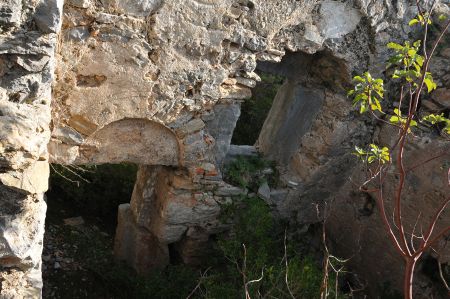 So we were curious, after the political side has repeatedly claimed that the cultural legacies of the pre-Seljuk past in Turkey are now being taken care of, which is what awaits us today. We are still too aware of the stubbornness with which Europe, the USA and Russia have been demanding the return of certain artefacts in recent years and what draconian measures (withdrawal of excavation permits, requirements for the design of paths and areas at excavation sites, the installation of fences, etc.) were threatened, should the claims not be met.
So we were curious, after the political side has repeatedly claimed that the cultural legacies of the pre-Seljuk past in Turkey are now being taken care of, which is what awaits us today. We are still too aware of the stubbornness with which Europe, the USA and Russia have been demanding the return of certain artefacts in recent years and what draconian measures (withdrawal of excavation permits, requirements for the design of paths and areas at excavation sites, the installation of fences, etc.) were threatened, should the claims not be met.
At the time, the Turkish Minister of Culture Ömer Çelik reclaimed five ancient treasures from Berlin and raised serious allegations against the Prussian Cultural Heritage Foundation and against German archaeologists. In the Spiegel interview, the Minister of Culture Çelik had demanded the return of various artefacts from Berlin, which he believed had been exported illegally from Turkey: the torso of the "Fisherman of Aphrodisias" from the Old Museum, the sarcophagus of Haci-Ibrahim-Veli -Tombs from the Museum of Islamic Art, a 13th-century prayer niche and casement window from the Beyhekim Mosque and the Iznik tiles from the Piyale Pasha Mosque.
Parts of a world heritage site under water
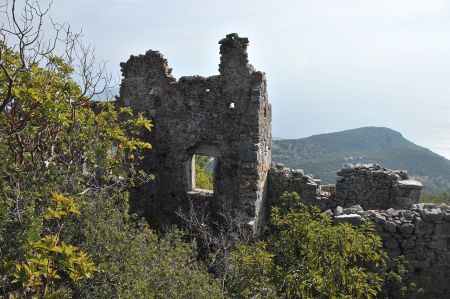 The Prussian Cultural Heritage Foundation replied that the "Fischer" was legal by purchase in Berlin. The other subject of dispute: the prayer niche from the 13th-century Beyhekim Mosque in Konya: Berlin said it was legally acquired from Turkey. The "Sphinx of Hattuscha" from the Museum of Near Eastern Art was reclaimed by the Turkish government in 2011. Already at that time there were threats of the withdrawal of excavation licenses from German archaeologists. In July 2011, the Sphinx began its journey home and is now united with its sister in the Istanbul Archaeological Museum, who had already returned to Turkey in 1924, a second Sphinx from the eponymous gate of the city of Hattusha.
The Prussian Cultural Heritage Foundation replied that the "Fischer" was legal by purchase in Berlin. The other subject of dispute: the prayer niche from the 13th-century Beyhekim Mosque in Konya: Berlin said it was legally acquired from Turkey. The "Sphinx of Hattuscha" from the Museum of Near Eastern Art was reclaimed by the Turkish government in 2011. Already at that time there were threats of the withdrawal of excavation licenses from German archaeologists. In July 2011, the Sphinx began its journey home and is now united with its sister in the Istanbul Archaeological Museum, who had already returned to Turkey in 1924, a second Sphinx from the eponymous gate of the city of Hattusha.
The President of the Prussian Cultural Heritage Foundation, Herrmann Parzinger, had already reacted angrily to the behavior of the Turkish side in December 2012. He is annoyed about loans that have been promised and then not released, about demands for the return of ancient treasures from Berlin and about Turkey's unwillingness to cooperate with archaeological excavations.
An excavation site at which German archaeologists are researching has existed in Miletus for decades. The Turkish Minister of Culture Ömer Çelik also told the "Spiegel" that "they have been digging and working here for 114 years, but to this day there has not even been a drainage system. Accordingly, parts of a world heritage site are under water".
If the Turkish side had known about this state of affairs in Miletus, it was our question at the time, and could they not have reacted long ago and taken care of the drainage themselves? Why are archaeologists solely responsible?
Leave site as "Desert Landscape"
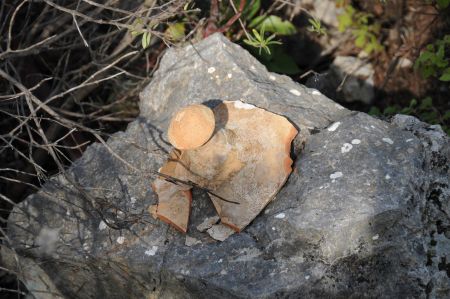 The 2nd century AD market gate of Miletus was transferred to Berlin in the early 20th century with the permission of the Turkish authorities. Along with the Pergamon Altar, it is one of the main attractions of the Pergamon Museum on Museum Island. The gate was last restored in 2007/2008.
The 2nd century AD market gate of Miletus was transferred to Berlin in the early 20th century with the permission of the Turkish authorities. Along with the Pergamon Altar, it is one of the main attractions of the Pergamon Museum on Museum Island. The gate was last restored in 2007/2008.
As early as December, Hermann Parzinger had rejected any claim regarding the three other objects – the torso, the sarcophagus and the prayer niche. They had come to Germany legally, he also told the “Spiegel” at the time. At the same time, he had said about the refusal of excavation licenses for German and French archaeologists and the Turkish state's lack of willingness to cooperate: "The way Turkey is behaving now sometimes seems almost chauvinistic to me." Çelik immediately demanded an apology for this sentence.
Many Germans in Turkey would not comply with the standards and leave the sites as a "desert landscape". As an example, he cites Göbekli Tepe in south-east Anatolia – where an 11,500-year-old statue was stolen in 2000, allegedly because of inadequate German security measures.
Why doesn't Turkey take care of missing or inadequate security measures, when one knows how at least part of the population thinks and acts about excavation measures and the removal of cultural property?
President of the German Archaeological Institute
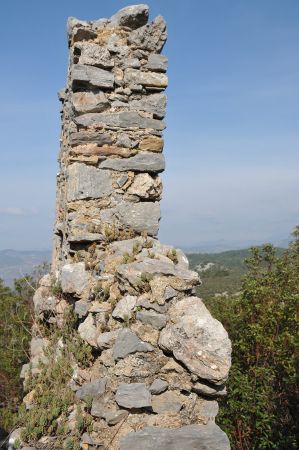 However, the Turkish Minister of Culture denied a connection between the reluctance to grant or refuse excavation licenses and the rejected demands for return. "We withdrew the permits because the standards were not met," the statement said. There are no other reasons. Parzinger, who was President of the German Archaeological Institute before taking office at the foundation in 2008, had already declared in December that Turkey could, conversely, recognize “what foreign archaeologists do for the preservation of the cultural heritage of all people and thus indirectly also for the enormous have contributed to the development of tourism in Turkey”.
However, the Turkish Minister of Culture denied a connection between the reluctance to grant or refuse excavation licenses and the rejected demands for return. "We withdrew the permits because the standards were not met," the statement said. There are no other reasons. Parzinger, who was President of the German Archaeological Institute before taking office at the foundation in 2008, had already declared in December that Turkey could, conversely, recognize “what foreign archaeologists do for the preservation of the cultural heritage of all people and thus indirectly also for the enormous have contributed to the development of tourism in Turkey”.
It would be so easy to cooperate with each other, especially in the field of historical cultural assets. There are hundreds of examples where cultural property has become the scene and backdrop of theatre and music events, so that it is preserved in this way. Yes, even new businesses have emerged on this basis and contribute to the preservation of the cultural heritage through public relations and events. It doesn't matter whether it's a Roman or medieval festival, jousting or legion festivals.
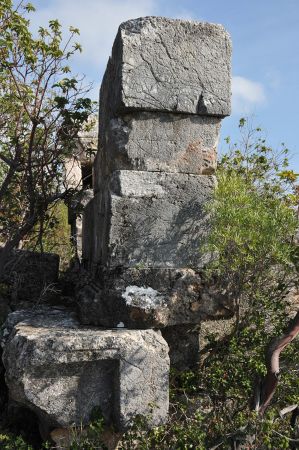 After reaching the village environment at the foot of the mountain, which we were familiar with from our first visit, the first surprise came. A wide locked courtyard gate barred the ascent to Hamaxia. When asked about access, we were directed to a narrow path along a newly constructed stone wall and fence surrounding a now developed property.
After reaching the village environment at the foot of the mountain, which we were familiar with from our first visit, the first surprise came. A wide locked courtyard gate barred the ascent to Hamaxia. When asked about access, we were directed to a narrow path along a newly constructed stone wall and fence surrounding a now developed property.
First of all, however, we were interested in the ancient cistern, which was partially open at the end of the village and filled with wonderfully clear, bluish shimmering water on our last visit. Approximately 6 by 2.5 meters in size, even the supporting pillars of the stone slabs of the roof construction were designed as chapters. What wealth must have once reigned here in Hamaxia. Perhaps you, dear reader, have already heard of the Sunken Palace in Istanbul, a huge water cistern from Greco-Roman times that is now one of Istanbul's tourist highlights. And how depressing was the sight of this little cistern lying in front of us without water, dirty and almost filled up with a lot of rubbish. What else can we expect?
Columns of the stone slabs of the roof construction designed as chapters
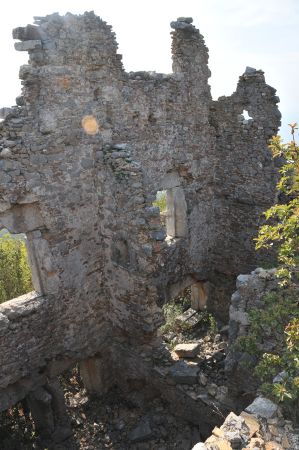 First along the fence we started the ascent. The remains of the city wall and the first ruins of buildings that lay outside the city walls can be seen from afar. Every now and then one encountered pit that could clearly be assigned to excavation robbers. The ascent became more and more difficult, because there were no longer even goat paths, the vegetation was so dense through the undergrowth. It was really exhausting and hard to find your way through thorns and bushes. On the other hand, we could no longer find the main street of Hamaxia, which we can still clearly see, with its rows of buildings to the left and right. Either walls and gables had fallen in so that the main path was no longer visible, or we simply couldn't find it. In spite of all the vegetation, which did not stop at the walls, a number of gables and parts of the building were still preserved. For how much longer?
First along the fence we started the ascent. The remains of the city wall and the first ruins of buildings that lay outside the city walls can be seen from afar. Every now and then one encountered pit that could clearly be assigned to excavation robbers. The ascent became more and more difficult, because there were no longer even goat paths, the vegetation was so dense through the undergrowth. It was really exhausting and hard to find your way through thorns and bushes. On the other hand, we could no longer find the main street of Hamaxia, which we can still clearly see, with its rows of buildings to the left and right. Either walls and gables had fallen in so that the main path was no longer visible, or we simply couldn't find it. In spite of all the vegetation, which did not stop at the walls, a number of gables and parts of the building were still preserved. For how much longer?
After about 2 hours of climbing through undergrowth and many small injuries and scratches, we started the descent. Just don't go back through the city area, but around the outside, along the wall.
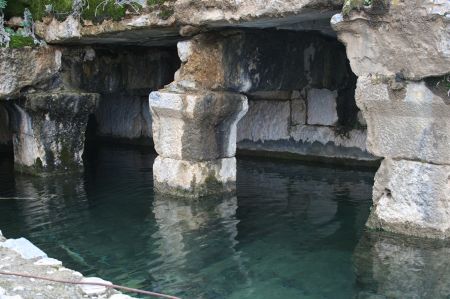 What a grandiose view resulted from here on Alanya and its beautiful Cleopatra beach. And how easy it would be to develop Hamaxia as a further attraction for cultural tourists if one would first only create a hiking trail up to the city walls of Hamaxia using the existing goat paths. Then remove bushes and shrubs from the ruins and thus create another tourist destination for travellers interested in culture.
What a grandiose view resulted from here on Alanya and its beautiful Cleopatra beach. And how easy it would be to develop Hamaxia as a further attraction for cultural tourists if one would first only create a hiking trail up to the city walls of Hamaxia using the existing goat paths. Then remove bushes and shrubs from the ruins and thus create another tourist destination for travellers interested in culture.
Please read as well:
Tersane Dockyard Alanya - monument of Seldjuks
Red Tower of Alanya - City symbol from Sultan Keykubat
-
 Hamaxia-cistern Alanya today
Hamaxia-cistern Alanya today
Hamaxia-cistern Alanya today
Hamaxia-cistern Alanya today
-
 Hamaxia next to Alanya
Hamaxia next to Alanya
Hamaxia next to Alanya
Hamaxia next to Alanya
-
 Hamaxia next to Alanya
Hamaxia next to Alanya
Hamaxia next to Alanya
Hamaxia next to Alanya
-
 Hamaxia next to Alanya
Hamaxia next to Alanya
Hamaxia next to Alanya
Hamaxia next to Alanya
-
 Hamaxia next to Alanya
Hamaxia next to Alanya
Hamaxia next to Alanya
Hamaxia next to Alanya
-
 Hamaxia next to Alanya
Hamaxia next to Alanya
Hamaxia next to Alanya
Hamaxia next to Alanya
-
 Hamaxia next to Alanya
Hamaxia next to Alanya
Hamaxia next to Alanya
Hamaxia next to Alanya
-
 Hamaxia next to Alanya
Hamaxia next to Alanya
Hamaxia next to Alanya
Hamaxia next to Alanya
-
 Hamaxia next to Alanya
Hamaxia next to Alanya
Hamaxia next to Alanya
Hamaxia next to Alanya
-
 Hamaxia next to Alanya
Hamaxia next to Alanya
Hamaxia next to Alanya
Hamaxia next to Alanya
-
 Hamaxia next to Alanya
Hamaxia next to Alanya
Hamaxia next to Alanya
Hamaxia next to Alanya
-
 Hamaxia next to Alanya
Hamaxia next to Alanya
Hamaxia next to Alanya
Hamaxia next to Alanya
-
 Hamaxia next to Alanya
Hamaxia next to Alanya
Hamaxia next to Alanya
Hamaxia next to Alanya
-
 Hamaxia next to Alanya
Hamaxia next to Alanya
Hamaxia next to Alanya
Hamaxia next to Alanya
-
 Hamaxia next to Alanya
Hamaxia next to Alanya
Hamaxia next to Alanya
Hamaxia next to Alanya
-
 Hamaxia next to Alanya
Hamaxia next to Alanya
Hamaxia next to Alanya
Hamaxia next to Alanya
-
 Hamaxia-cistern Alanya 1997
Hamaxia-cistern Alanya 1997
Hamaxia-cistern Alanya 1997
Hamaxia-cistern Alanya 1997
-
 Hamaxia next to Alanya
Hamaxia next to Alanya
Hamaxia next to Alanya
Hamaxia next to Alanya
-
 Hamaxia next to Alanya
Hamaxia next to Alanya
Hamaxia next to Alanya
Hamaxia next to Alanya
-
 Hamaxia next to Alanya
Hamaxia next to Alanya
Hamaxia next to Alanya
Hamaxia next to Alanya
-
 Hamaxia next to Alanya
Hamaxia next to Alanya
Hamaxia next to Alanya
Hamaxia next to Alanya
https://www.alaturka.info/en/turkey-country/riviera/6092-hamaxia-lost-city-near-alanya#sigProId99ccd9f2d0
